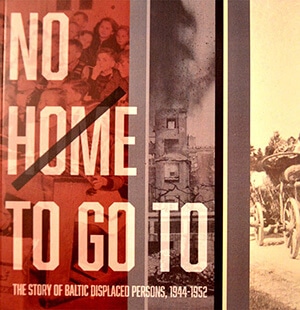 The traveling exhibit commemorating the 70th anniversary of the exodus of refugees from the Baltic Republic continues its North American tour.
The traveling exhibit commemorating the 70th anniversary of the exodus of refugees from the Baltic Republic continues its North American tour.
It will be on display at the United Nations from August 15 to 27, 2016 and then will move to the Science, Industry and Business Library (public library) in New York, October 7 to December 31, 2016. After its opening in Chicago the exhibit has traveled to Washington D.C., Philadelphia, Ontario and several places in Lithuania.
The objective of the exhibit is to communicate the tragic history of the Baltic Republics directly from the eye witnesses before they are lost to history. Since the mass exodus from the Baltics occurred more than 70 years ago, this may be the last opportunity to systematically document the circumstances that forced so many families to flee.
Each month there are fewer people left that can personally tell the fascinating details of life during those times. It is essential that we preserve this information to (1) a large audience in the United States and Canada, (2) to our own offspring who only vaguely understand what took place and (3) to people in Estonia.
This exhibit and ancillary activities have received financial support from the Estonian National Archive and the Ministry of Foreign Affairs, as well as numerous Latvian and Lithuanian organizations and individuals. While the traveling exhibit is largely a display of laminated photographs on boards and tables, the larger effort included collecting and organizing material to accurately communicate the harsh conditions and difficult decisions facing ordinary families at that time.
The aim is to record the circumstances that dictated (1) the mass exodus of families, (2) their lives in the displaced persons (DP) camps and (3) their early months in North America. The emphasis is on the first two elements.
The exhibit was developed by the Balzekas Museum of Lithuanian Culture with the active participation of the Estonians and Latvians. For full disclosure, my family’s journey is also included in the exhibit. The arrival of the Soviet forces in 1944 was an excruciatingly difficult time for all Estonians.
My family escaped to Germany in 1940 and returned to Estonia in 1942. We were miraculously able to escape again in 1944, expecting to return to Estonia upon Soviet departure. We waited in Germany for six years before emigrating to the United States. My mother-in-law escaped from Estonia with her child in the summer of 1944 (her husband was conscripted into the German army) under the belief that she would soon return home. Her mother stayed in Estonia and was sent to Siberia where she died under uncertain circumstances. These stories need to be documented and remembered. This is the major goal of the exhibit.
A booklet accompanies this “No Home To Go To” exhibit and it has received wide-spread publicity, including the cover of the magazine STREETWISE.













